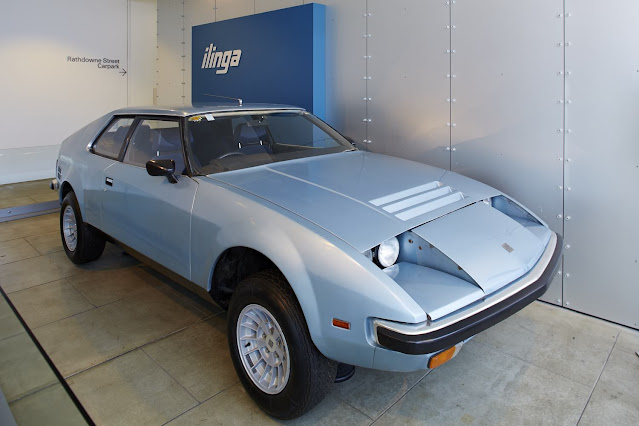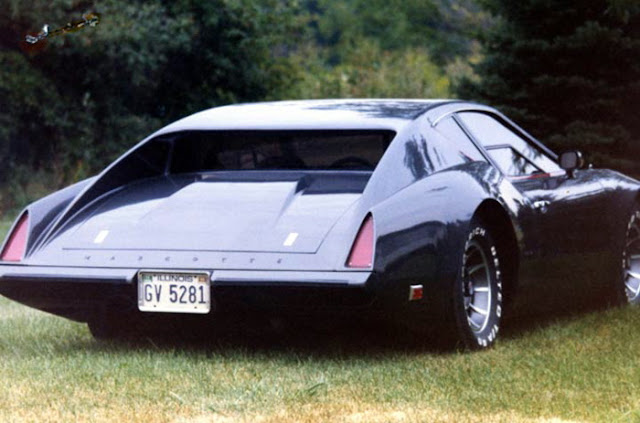Named for an aboriginal word meaning 'distant horizon', Ilinga Pty. Ltd. was incorporated in May of 1973. A factory was established at 30 Beaconsfield Parade, Port Melbourne in 1974. The company publicized the Ilinga as "the name for a car which has brought true luxury into the Australian car industry". The Ilinga AF-2 was intended to be a high-performance, two-door grand tourer.
The car was first presented at the 1975 Melbourne Motor Show and the AF-2 was built to compete with the likes of Porsche and Aston Martin. It was designed by British-born racing car driver and engineer Tony Farrell in partnership with Melbourne businessman Daryl Davies.
 |
| The Ilinga AF-2, at rear |
The AF-2 was built using an aluminum body on a steel chassis, fitted with three roll-over bars, and featured crumple zones for added safety. The chassis was based on a Ford Cortina floor plan and was originally envisioned with a Noryl plastic body. The chassis design in many respects was ahead of its time with a rigid passenger cell strengthened by three roll bars and crumple zones.
Designed around a modified Rover 4.4 liter V8 engine sourced from the Leyland P76, the AF-2 was to be fitted with a four-speed manual or three-speed automatic Borg-Warner transmission, 4 wheel independent suspension, with coil-over struts, pop-up headlights, and central locking doors. It also featured a modern interior with Recaro seats, a digital clock, a self-seeking cassette player with radio, electric windows, and a fully integrated air conditioning unit.
 |
| The Ilinga AF-2 interior |
It was intended to be sold at the retail price of AUD$16-18,000. The firm had plans to build two cars per week (100 cars per year) but ran into financial difficulties associated with staff and tooling expenditure for production. Their troubles were further compounded by supply and warranty problems with the Borg Warner 35 transmission which failed to cope with the Ilinga's additional horsepower. The demise of the Leyland P76 also led to the loss of its local engine source. Finally, the oil crisis of the early 1970s caused a drastic change in consumer preferences toward more fuel efficient cars.
These factors came together to seal the fate of the AF-2, with only two prototypes being produced. Despite its innovations and ambitious goals, it became a car without a market. A tantalizing lost horizon...
 |
| The Ilinga AF-2 rides off into the sunset |
The first of the two completed prototypes was donated to the Museum Victoria in Melbourne, by Mr. Ian Dodd, who had owned it since 1977. The other was reportedly used as a daily driver by an Australian restauranteur and re-painted green (from its original color, a metallic powder blue). It awaits restoration.
 |
| The Ilinga AF-2 |
 |
| The Ilinga AF-2, right-rear view |
 |
| The Ilinga AF-2 interior |
 |
| The Ilinga AF-2 on the open road |
 |
| The Ilinga AF-2, front-right view |
 |
| The Ilinga AF-2 |
 |
| The Ilinga AF-2's tuned Leyland P76 motor |
 |
| The Ilinga AF-2 in profile |
 |
| The Ilinga AF-2, head on |
 |
| The Ilinga AF-2, on a test track |
 |
| The Ilinga AF-2, from above |



















I interviewed the late Tony Farrell,who headed the Ilinga project, for a Unique Cars article published about 20 years ago. He confirmed that issues with the Borg-Warner auto caused production to be halted after 40 deposits were taken and 10 cars fully or part-completed.
ReplyDeleteI was only aware of two completed examples, a prototype and one production car which was delivered to a customer. Do you happen to know the fate of the other ones that you mention?
DeleteI will be happy to amend my article if there were, in fact, more Ilingas completed.
Thank you for your input!
I was actually involved with this Project from early days and leaked and broke the first stories in collaboration with the boys... Darryl and Tony. Darryl started and ran Davies Craig cooling fans. I helped them acquire the Recaros for the seating. I suggested getting a car designer involved to improve the styling but they were too far down the road with the existing design and just did some tweaks. It was a well-intended Project by two great guys... it was also unfortunate they picked a Leyland-based drivetrain... which of course had an ideal engine, but a limited gearbox.. they invested a lot of time and money and the Project was ahead of its time. Given reasonable luck, they would have succeeded as they had more than 40 people prepared to put up deposits ... regardless of what people think of the appearance... certainly there are uglier cars that have sold well... it was another earnest attempt at a time of great innovation in Australia ... not easily appreciated by the armchair knockers of today... most of whom couldn't build a lego car..
ReplyDeleteGreat to hear from you, Rob. I certainly took the car to be a serious endeavor and hope that comes across in the article. I think the styling of the car was rather handsome for the time and it had a number of innovative features. It was an ambitious effort to be sure and I think the market conditions of the era would have made for a tough slog even if they hadn't suffered supply chain issues. Nonetheless, I think it would have been competitive among its potential peers.
DeleteThere were a number of similar efforts, like the Monica, that met similar fates for many of the same reasons. The "malaise era" culled many makers of specialty cars across the globe. Even storied marques like Lamborghini, Ferrari, and Aston Martin struggled to survive.
At any rate, I welcome any input, corrections, and/or additional information. It is my aim to provide as concise and accurate a body of information on this blog as possible.